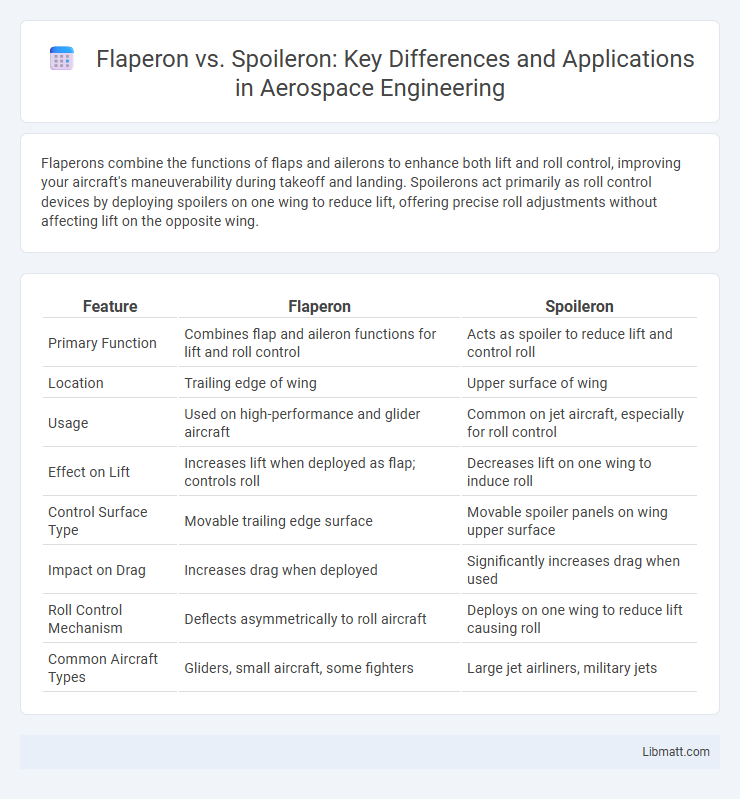Flaperons combine the functions of flaps and ailerons to enhance both lift and roll control, improving your aircraft's maneuverability during takeoff and landing. Spoilerons act primarily as roll control devices by deploying spoilers on one wing to reduce lift, offering precise roll adjustments without affecting lift on the opposite wing.
Table of Comparison
| Feature | Flaperon | Spoileron |
|---|---|---|
| Primary Function | Combines flap and aileron functions for lift and roll control | Acts as spoiler to reduce lift and control roll |
| Location | Trailing edge of wing | Upper surface of wing |
| Usage | Used on high-performance and glider aircraft | Common on jet aircraft, especially for roll control |
| Effect on Lift | Increases lift when deployed as flap; controls roll | Decreases lift on one wing to induce roll |
| Control Surface Type | Movable trailing edge surface | Movable spoiler panels on wing upper surface |
| Impact on Drag | Increases drag when deployed | Significantly increases drag when used |
| Roll Control Mechanism | Deflects asymmetrically to roll aircraft | Deploys on one wing to reduce lift causing roll |
| Common Aircraft Types | Gliders, small aircraft, some fighters | Large jet airliners, military jets |
Introduction to Aircraft Control Surfaces
Flaperons combine the functions of flaps and ailerons, allowing pilots to control both roll and lift by adjusting wing camber and angle. Spoilerons serve primarily as roll control devices by deploying spoilers on one wing to reduce lift and induce rolling motion without altering the wing's angle of attack. Both surfaces enhance aircraft maneuverability and efficiency but differ in their mechanisms and aerodynamic effects.
What is a Flaperon?
A flaperon is an aircraft control surface that combines the functions of both flaps and ailerons, allowing it to increase lift during takeoff and landing while also providing roll control. Positioned on the trailing edge of the wing, flaperons can deflect symmetrically to act as flaps or asymmetrically to act as ailerons. This dual functionality enhances aerodynamic efficiency and reduces the need for separate control surfaces, often found on modern light aircraft and gliders.
What is a Spoileron?
A spoileron is a flight control surface that combines the functions of a spoiler and an aileron, primarily used to control an aircraft's roll by disrupting airflow over the wing to reduce lift on one side. Unlike traditional ailerons which deflect up or down, spoilerons extend upward to decrease lift and increase drag, aiding in precise roll control and improved maneuverability. Your aircraft may use spoilerons to enhance roll response, especially in modern fly-by-wire systems where smooth and efficient control is critical.
Flaperon: Design and Functionality
Flaperons combine the functions of flaps and ailerons into a single control surface, enhancing both lift and roll control on aircraft wings. Their design allows for smoother aerodynamic transitions by adjusting the wing's camber while maintaining effective roll response, which optimizes performance during takeoff, landing, and in-flight maneuvers. Your aircraft benefits from flaperons by improving aerodynamic efficiency and control precision without the need for separate flap and aileron surfaces.
Spoileron: Design and Functionality
Spoilerons are aircraft control surfaces that combine the functions of spoilers and ailerons, providing roll control by disrupting airflow over the wing to reduce lift on one side, which enhances maneuverability. Unlike traditional ailerons, spoilerons primarily decrease lift rather than increase it, offering precise roll response and improved aerodynamic efficiency, especially on large commercial aircraft. Their design integrates seamlessly into the wing structure, allowing for smoother surface transitions and reduced drag compared to separate spoiler and aileron systems.
Flaperon vs Spoileron: Key Differences
Flaperons combine the functions of both flaps and ailerons, enabling roll control and lift augmentation on a single control surface, commonly used in light aircraft and UAVs to reduce weight and complexity. Spoilerons function solely as roll control devices by deploying spoilers on one wing to reduce lift and induce roll, without contributing to lift augmentation, often found in larger commercial aircraft for precise roll response. The key differences lie in flaperons' dual role in lift and roll management versus spoilerons' exclusive use for roll control by lift reduction.
Aerodynamic Impact of Flaperons
Flaperons combine the functions of flaps and ailerons, enhancing both lift and roll control during flight, which improves overall aerodynamic efficiency. Their ability to alter the wing's camber increases lift at lower speeds, significantly aiding takeoff and landing performance. You benefit from more responsive handling and smoother control transitions compared to traditional spoilerons, which primarily reduce lift to assist with roll.
Aerodynamic Impact of Spoilerons
Spoilerons primarily disrupt airflow over the wing, reducing lift and increasing drag on the side deployed, which enhances roll control and contributes to aircraft deceleration. Unlike flaperons, which combine flap and aileron functions to increase lift while controlling roll, spoilerons provide more precise and immediate aerodynamic braking and roll response. Your aircraft benefits from spoilerons' ability to optimize lift distribution and aerodynamic efficiency during complex maneuvers and descent.
Applications in Modern Aircraft
Flaperons combine the functions of flaps and ailerons, improving lift and roll control on modern light aircraft and drones. Spoilerons primarily act as roll control devices, using spoilers to reduce lift on one wing, commonly found in commercial airliners and high-performance jets. Your understanding of these control surfaces helps optimize aircraft maneuverability and performance in various flight conditions.
Conclusion: Choosing Between Flaperon and Spoileron
Choosing between flaperons and spoilerons depends on your aircraft's specific flight control needs and performance goals. Flaperons combine the functions of flaps and ailerons, enhancing lift and roll control, making them ideal for aircraft requiring versatility and improved low-speed handling. Spoilerons primarily assist in roll control by disrupting lift on one wing, offering precise and rapid roll response without affecting lift as much, which can be advantageous for high-speed or aerobatic flight profiles.
Flaperon vs Spoileron Infographic

 libmatt.com
libmatt.com